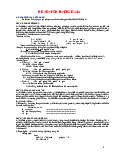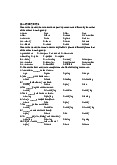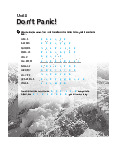




Preview text:
SAMPLE: Code :_(1)_ FINAL EXAM SEMESTER , ACADEMIC YEAR 2333 2023 - 2024
COURSE NAME: ENGLISH SEMANTICS COURSE CODE: ANH404DE03
Time allowed: 90 minutes (this doesn’t include times for distributing exam papers) Instructions (3):
Exam question papers collected
Exam question papers not collected
Use the multiple-choice and (or) essay
Only use the essay question answer sheet question answer sheets
Portable calculators not allowed Open-book exam Closed-book exam
Allowed materials (if any) (4): ……………………………………………………………….
Other materials are not allowed.
Other instructions (if any) (5): ……………………………………………………………………
Full name: …………………………………. Proctor 1: Proctor 2:
(signature and full name)
(signature and full name)
Student ID: ……………Class: ……………
Exam date: ………………………………… Overall grade Comments Examiner
(for the midterm exam only)
(signature and full name) 10-point grade Letter grade
PART 1. Choose the words or phrases that best answer the following questions. Write your
answers (A,B,C, or D) on the table below. (15 x 1 = 15pts.) 1.
Of what degree is the predicate identical in Your house is identical to mine? A. One B. Two C. Three D. Either B or C 2.
What is The book we bought yesterday in The book we bought yesterday is on the desk? 1 | 5
A. a definite noun phrase functioning as a referring expression
B. an indefinite noun phrase functioning as a referring expression C. not a referring expression D. Either A or B 3. …. …. 15. … Answer: 1. 2. 3. 4. 5. 6. 7. 8. 9. 10. 11. 12. 13. 14. 15.
PART 2. Match the sentence types in column A with the example sentences in column B. Write
your answers on the table below. The first one (number 0) is done as example. . (10 x 1.5 = 15pts.) A B
0. It can be said to belong to a particular language but A. EXTENSION not to a particular accent.
1. It is dependent of particular occasions or utterance and B. PROPOSITION
does not involve a set of anything.
2. It is independent of particular occasions or utterance and C. SENSE
involves a set of physical objects.
3. It is independent of particular occasions or utterance and D. SENTENCE
does not involve a set of anything.
4. It can be true or false but cannot be said to be E. REFERENT grammatical or not. 5. … F. … … …. 10. K. … 2 | 5 Answer: 0. D 1. 2. 3. 4. 5. 6. 7. 8. 9. 10.
PART 3. Identify the sense properties of the following sentences. Write A (analytic), S (synthetic) or
C (contradictory) on the blank right before each question to indicate your answers. The first
question (number 0) is done as an example. (10 x 1 = 10pts.)
A 0. A whale is a mammal.
_________ 1. All elephants are animals.
_________ 2. This interesting movie is not interesting at all. _________ 3. … _________ … _________ 10. …
PART 4. Identify the sense relation between the predicates or the sentences in each of the following
pairs. Write the letter that indicates your answer on the blank right before each question. The first
question (number 0) is done as an example. (20 x 1.0 = 20 points) Sense relations: D. gradable antonymy H. polysemy A. synonymy E. multiple incompatibility I. paraphrase B. binary antonymy F. hyponymy J. entailment C. converseness G. homonymy K. contradictoriness D
0. hot – cold
_____ 1. parent - child
_____ 2. dead - alive _____ 3. …. _____ … _____ 20. …. 3 | 5
PART 5. For each of the following words, give TWO full sentences which include the word and
which bring out its distinct senses. The first question (number 0) is done as an example. (2 x 4 = 8pts.) 0. Hard:
Sentence 1: Playing violin is hard.
Sentence 2: This wood is hard. 1. Steer: Sentence 1: Sentence 2: 2. …: Sentence 1: Sentence 2:
PART 6. For each of the following sentences give TWO paraphrases which are not paraphrases of ,
each other. The first question (number 0) is done as an example. (2 x 8 = 16pts.)
0. Visiting relatives can be boring.
Paraphrase 1: It can be boring to visit relatives.
Paraphrase 2: Relatives who are visiting can be boring.
1. They observed the children in the garden. Paraphrase 1: Paraphrase 2: 2. ….. Paraphrase 1: Paraphrase 2:
PART 7. For each of the following utterances, give TWO situations in which it can be used and
identify its illocution in these two different situations. The first question (number 0) is done as an example. (2 x 8 = 16pts.)
0. ‘Why don’t you send it by post?’ 4 | 5 Situation 1:
John: ‘Why don’t you send it by post?’
Mary: ‘Because it’s too slow.’
John performs a direct illocutionary act of asking.
Situation 2: Jack: ‘Why don’t you send it by post?’
Jill: ‘That’s a good idea.’
Jack performs an indirect illocutionary act of making a suggestion.
1. “These bags are so heavy.” Situation 1:
__________________________________________________________________
__________________________________________________________________
__________________________________________________________________ Situation 2:
__________________________________________________________________
__________________________________________________________________
__________________________________________________________________ 2. … Situation 1:
__________________________________________________________________
__________________________________________________________________
__________________________________________________________________ Situation 2:
__________________________________________________________________
__________________________________________________________________
__________________________________________________________________ THE END 5 | 5




